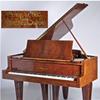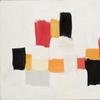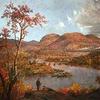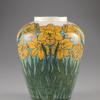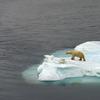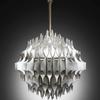Step Inside the Smithsonian Exhibition Revealing One Prussian Explorer’s Profound Impact on American Identity
- May 03, 2020 17:05
Alexander von Humboldt and the United States: Art, Nature and Culture is the first exhibition to examine Humboldt’s impact on five spheres of American cultural development: the visual arts, sciences, literature, politics and exploration, between 1804 and 1903. The exhibition was installed at the Smithsonian American Art Museum’s main building in March, and while shuttered during the coronavirus crisis, the museum offers a virtual tour of the show with senior curator, Eleanor Jones Harvey.
Humboldt (1769–1859) was a renowned Prussian naturalist and explorer and one of the most influential figures of the 19th century. He lived to his 90th year, published more than 36 books, traveled across four continents and wrote well over 25,000 letters to an international network of colleagues and admirers. In 1804, after traveling five years in South America and Mexico, Humboldt spent six weeks in the United States. In these six weeks, Humboldt—through a series of lively exchanges of ideas about the arts, science, politics and exploration with influential figures such as President Thomas Jefferson and artist Charles Willson Peale—shaped American perceptions of nature and the way American cultural identity became grounded in the natural world.
The exhibition centers on the fine arts as a lens through which to understand how deeply intertwined Humboldt’s ideas were with America’s emerging identity. It includes more than 100 paintings, sculptures, maps, and artifacts as well as a video introduction to Humboldt and his connections to the Smithsonian through an array of current projects and initiatives.
“Eleanor Jones Harvey has dusted for Humboldt’s fingerprints on American art and culture and found them nearly everywhere, including the founding of the Smithsonian Institution,” said Stephanie Stebich, the Margaret and Terry Stent Director of the Smithsonian American Art Museum. “The Smithsonian, with its vast range of disciplines and multitude of collections and ongoing research, is the perfect setting for this expansive evaluation of Humboldt’s impact in the United States. Humboldt encouraged American landscape painters to embrace our natural wonders as emblems of our cultural identity. As a country, we have much to thank Humboldt for, as reflected in the countless namesake places and species across our land. Most importantly, Humboldt’s influence on America’s love of and protection of nature is revealed in other prominent Americans’ legacies, such as Theodore Roosevelt and Rachel Carson.”
The exhibition places American art squarely in the center of a conversation about Humboldt’s lasting influence with artworks that reveal how the American wilderness became emblematic of the country’s distinctive character. Humboldt’s quest to understand the universe—his concern for deforestation and climate change, his taxonomic curiosity centered on New World species of flora and fauna and his belief that the arts were as important as the sciences for conveying the resultant sense of wonder in the interlocking aspects of our planet—make this a project evocative of how art illuminates some of the issues central to stewardship of the planet today. Artworks by Albert Bierstadt, Karl Bodmer, George Catlin, Frederic Church, Eastman Johnson, Samuel F.B. Morse, Charles Willson Peale, John Rogers, William James Stillman and John Quincy Adams Ward, among others, will be on display. Church, an esteemed painter of the Hudson River school, features prominently in the exhibition. He idolized Humboldt, going as far as trekking in the naturalist’s footsteps in South America.
The exhibition also includes the original “Peale Mastodon” skeleton, on loan from the Hessisches Landesmuseum Darmstadt, with ties to Humboldt, Peale and an emerging American national identity in the early 19th century. Its inclusion in the exhibition represents a homecoming for the important fossil that has been in Europe since 1847, and emphasizes that natural history and natural monuments bond Humboldt with the United States. The skeleton, excavated in 1801 in upstate New York, was the most complete to be unearthed at that time. Its discovery became a symbol of civic pride. In 1804, Humboldt was honored with a dinner beneath the mastodon while it was exhibited in the Peale Museum in Philadelphia. Two paintings featuring the fossil—“Exhumation of the Mastodon” (1806–08) and “The Artist in His Museum” (1822) both by Peale—are on display nearby in the galleries.
“This project sets out to recapture the immediate, sustained and profound impact of Humboldt’s ideas and understand how they shaped the works made by some of the most influential American artists of the 19th century who deliberately wove into their major paintings messages about American cultural identity,” Harvey said. “Collectively their efforts created a nature-based aesthetic so well recognized today that its roots are obscured, much in the way Humboldt’s concept of ‘Cosmos’ or ‘unity of nature’ has been accepted as received wisdom. That collaborative model lies at the heart of Humboldt’s enterprise and at that of the Smithsonian as well.”
The exhibition features a digital exploration of Church’s famous landscape, “Heart of the Andes” (1859), enabling visitors to engage with the painting’s details in new ways. The wealth of detail is a painterly extrapolation of Humboldt’s plant geography map. The mountain at the center of the work, Chimborazo, was referred to as “Humboldt’s Mountain.” The narrated, 2.5D animated projection enables visitors to appreciate the connections between Church’s painting and Humboldt’s ideas.
The exhibition concludes with a “One Smithsonian” Interpretive Lounge where visitors can explore the contemporary connections between Humboldt and the work being done across the Smithsonian today. Featured experts include Ximena Velez-Zuazo, marine managing director of the Biodiversity Monitoring and Assessment Program at the Smithsonian Conservation and Biology Institute’s Center of Conservation and Sustainability; Kristina Anderson-Teixeira, forest ecologist at the Smithsonian Conservation Biology Institute and the Smithsonian Tropical Research Institute; Mary Elliott, curator at the Smithsonian’s National Museum of African American History and Culture and a member of the Slave Wrecks Project International leadership team; and Sofia Elian, graphic designer at the Smithsonian Science Education Center.
The exhibition catalog, Alexander von Humboldt and the United States: Art, Nature and Culture, is written by Harvey with a preface by Hans Sues, chair of paleobiology and curator of vertebrate paleontology at the Smithsonian’s National Museum of Natural History. The book examines how Humboldt left a lasting impression on American visual arts, sciences, literature and politics. Humboldt inspired a network of like-minded individuals who would go on to embrace the spirit of exploration, decry slavery, advocate for the welfare of Native Americans, and extol America’s wilderness as a signature component of the nation’s sense of self. Harvey traces how Humboldt’s ideas influenced the transcendentalists and the landscape painters of the Hudson River school, and laid the foundations for the Smithsonian, the Sierra Club and the National Park Service. Co-published by the Smithsonian American Art Museum and Princeton University Press, it is available for purchase ($75) in the museum store and online.







